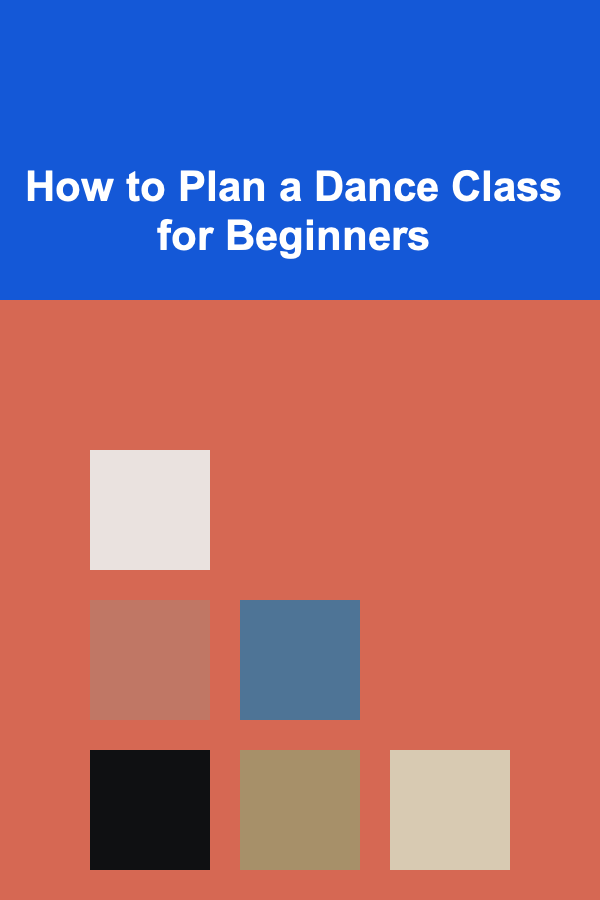
How to Plan a Dance Class for Beginners
ebook include PDF & Audio bundle (Micro Guide)
$12.99$6.99
Limited Time Offer! Order within the next:

Planning a dance class for beginners can be both exciting and challenging. Dance is not only an excellent form of exercise, but it also promotes creativity, coordination, and confidence. Whether you're teaching children, adults, or mixed groups, the goal is to create a welcoming and enjoyable environment while providing a solid foundation for learning.
This guide will take you step by step through the process of planning a dance class for beginners. It includes everything from structuring the class to choosing the right music and teaching techniques to make your students feel comfortable and engaged. By the end of this article, you'll have a comprehensive understanding of how to plan a dance class that beginners will love.
Understand the Needs and Expectations of Beginners
Before you even begin planning the structure of your class, it's important to understand the needs and expectations of your students. Beginners, by nature, may not have much experience with dance, so your teaching style should be supportive and non-intimidating. Start by considering the following:
- Age Group: Are your students children, teenagers, or adults? Each age group will require a different approach and style of teaching. For example, children often need more visual and interactive cues, while adults may respond better to clear verbal instructions.
- Fitness Level: Beginners may come with varying levels of fitness. It's important to tailor the class to be accessible for everyone. Offer modifications for movements that may be challenging for some, and avoid overly complex routines that could lead to frustration.
- Goals: What do your students want to achieve? Some may be taking the class for fitness, others for self-expression, and some might want to learn specific dance styles. Understanding their motivations will help you adjust the content of your class accordingly.
By understanding your students' needs, you'll be able to design a class that is both enjoyable and effective.
Define the Dance Style and Focus of the Class
Once you know your students' expectations, you can decide on the dance style to focus on. The type of dance will heavily influence how you structure your class, the movements you introduce, and how you teach.
Common Beginner Dance Styles:
- Ballet: A great starting point for beginners as it teaches discipline, balance, and coordination. Ballet emphasizes posture, flexibility, and control.
- Hip-Hop: This energetic style attracts a younger crowd and focuses on body isolations, rhythm, and freestyle expression.
- Jazz: A fun and lively style that blends well with contemporary music. Jazz dance emphasizes jumps, turns, and fluid movement.
- Contemporary: A modern form of dance that combines elements of ballet and jazz, but focuses more on emotional expression and improvisation.
- Latin Dance: Styles like salsa or cha-cha are social dances that involve a lot of footwork, rhythm, and partner interaction.
Once you've chosen a style, make sure to keep in mind your class's fitness level and adjust the complexity of the steps accordingly. For beginners, simplicity is key---focus on the basics of the chosen style.
Create a Class Structure
A well-planned class structure is essential for keeping beginners engaged and ensuring they progress in their dance abilities. Here's a basic class structure that works well for most beginner dance classes:
Warm-up (5-10 minutes)
Start with a gentle warm-up to prepare the body for movement, increase flexibility, and prevent injuries. This is essential for beginners, as their bodies are not yet conditioned for dance-specific movements. Your warm-up should include:
- Light cardio: A quick jog or side-to-side steps to get the heart rate up.
- Stretching: Focus on major muscle groups like the hamstrings, calves, back, and shoulders.
- Joint mobility exercises: Rotate the wrists, ankles, neck, and hips to improve flexibility and range of motion.
A good warm-up not only prepares the body physically but also sets the tone for the class by helping students focus.
Introduction to the Basics (15-20 minutes)
This is where you'll break down the fundamental steps and movements of the dance style you're teaching. For beginners, focus on the following:
- Basic Steps: Introduce the foundational steps or movements that form the building blocks of the style. For example, if you're teaching salsa, start with basic footwork and rhythm.
- Posture and Alignment: Help students understand the importance of posture and body alignment. Proper alignment will prevent injuries and make movements more fluid.
- Simple Combinations: Create short combinations that incorporate the basic steps. Keep them simple, repeating them multiple times to build confidence.
Remember to use clear and concise verbal cues, and demonstrate movements slowly before gradually increasing speed.
Technique and Form Practice (10-15 minutes)
At this stage, it's important to build on the basics by focusing on technique and form. Break down movements into smaller, more manageable parts, allowing students to focus on mastering each piece.
- Footwork: Emphasize the importance of proper foot placement and weight distribution. Teach students to shift their weight smoothly between their feet and maintain balance.
- Body Positioning: Whether you're teaching a classical style like ballet or a more contemporary style like hip-hop, teach students how to properly position their arms, torso, and legs.
- Isolation: If relevant, work on isolating parts of the body (head, chest, hips, etc.) to improve control and coordination.
Encourage students to focus on quality over quantity. It's more important to get the technique right than to move quickly or jump ahead.
Routine Building (10-15 minutes)
Once students are comfortable with the basics and the technique, you can begin incorporating those movements into a short, simple routine. This helps beginners connect the dots between individual movements and understand how they flow together.
- Simple Routines: The routine should incorporate the steps you've taught and be simple enough for beginners to remember. Break it down into small sections and go over them repeatedly.
- Repetition: Repetition is key in any dance class. Give students ample time to practice the routine, and ensure they can execute each section with confidence before moving on to the next.
- Music Integration: Play the music to which the routine will be performed. This helps students get used to dancing with rhythm and timing.
Cool Down and Stretch (5-10 minutes)
Finish the class with a cool-down that focuses on stretching and relaxation. This helps prevent muscle stiffness and promotes recovery.
- Slow Movements: Gradually slow down the intensity of movements to bring the heart rate back to normal.
- Stretching: Focus on stretching the muscles that were used during the class. Hold each stretch for at least 20 seconds to help improve flexibility.
A cool-down also provides a moment for students to reflect on what they've learned and to wind down after the physical exertion.
Engage with the Students
Building a rapport with your students is essential for keeping them motivated and making them feel comfortable. As a dance teacher, you should aim to:
- Be Supportive: Encourage students, especially beginners, with positive reinforcement. Celebrate small victories to boost their confidence.
- Offer Constructive Feedback: When correcting a student's technique, focus on how they can improve, and provide clear instructions on what they should adjust.
- Create a Safe Environment: Ensure that your students feel safe both physically and emotionally. Create a space where they can make mistakes without fear of judgment.
Dancing can be intimidating for beginners, so fostering a supportive and non-judgmental environment will encourage them to keep coming back.
Select the Right Music
Music plays a critical role in a dance class. It sets the mood, provides rhythm, and motivates students to keep moving. When selecting music for your beginner class, consider the following:
- Tempo: Choose music with a tempo that aligns with the dance style and your students' abilities. For beginners, slower tempos are easier to follow.
- Clear Beat: Pick songs with a clear, consistent beat. This makes it easier for students to follow the rhythm and stay on time with their movements.
- Variety: Offer a mix of music styles to keep the class fresh and exciting. Experiment with different genres to keep things interesting.
If you're teaching a specific style, such as jazz or salsa, try to use music that fits the genre's traditional sound and rhythm.
Plan for Different Learning Styles
Every student learns differently. Some may prefer visual cues, while others might need verbal explanations or hands-on assistance. It's important to cater to a variety of learning styles in your class. Here's how you can do this:
- Demonstrations: Show movements and routines several times so that visual learners can follow along.
- Verbal Instructions: Use clear, concise language to describe the movements. Be specific about body parts and their positioning.
- Hands-on Corrections: If appropriate, gently adjust a student's posture or movements to help them understand how to perform the step correctly.
By using a combination of teaching methods, you can ensure that all students, regardless of their learning style, can grasp the material.
Evaluate Progress and Adjust the Class
As the class progresses, keep an eye on how your students are doing. Are they improving, or do you notice any common challenges? Use this feedback to adjust future classes. If they're struggling with certain steps, take extra time to break them down further. If they're progressing quickly, challenge them with more complex movements to keep them engaged.
Conclusion
Planning a dance class for beginners is about balancing structure with creativity. It's important to make the class enjoyable while ensuring that students are learning the essential skills and techniques of the dance style. By understanding your students' needs, creating a solid class structure, and using effective teaching methods, you'll be able to foster a fun, supportive, and productive environment. With practice and attention to detail, you can help your beginners build confidence, improve their technique, and develop a love for dance.
Reading More From Our Other Websites
- [Home Party Planning 101] How to Design a Killer Party Invitation: From Digital Delights to DIY Masterpieces
- [Personal Finance Management 101] How to Utilize Coupons and Discounts Wisely
- [Home Pet Care 101] How to Introduce a New Scent to Your Anxious Dog
- [Home Party Planning 101] How to Organize a Surprise Party Without Giving It Away
- [Home Space Saving 101] How to Utilize Under-the-Bed Storage for Maximum Space Efficiency
- [Hiking with Kids Tip 101] Trail-Ready Tots: Choosing the Perfect Baby Carrier for Hiking Adventures
- [Organization Tip 101] How to Use a Rolling Cart for Flexible Storage Solutions
- [Home Lighting 101] How to Integrate IKEA Smart Lights into Your Home Office
- [Organization Tip 101] How to Patch Holes and Cracks in Drywall Like a Pro
- [Star Gazing Tip 101] Mysteries of the Solar System: Unveiling the Secrets of Each Planet

How to Create a Personal Retreat in Your Bedroom
Read More
How to Make a Statement with Holiday Wreaths in Your Home
Read More
Top Ways to Save Money on Pet Food and Supplies for Every Pet Owner
Read More
How To Develop Your Artistic Talents
Read More
Feng Shui for Stress Reduction and Mental Clarity
Read More
How to Create Printable Bookmarks for Book Clubs
Read MoreOther Products

How to Create a Personal Retreat in Your Bedroom
Read More
How to Make a Statement with Holiday Wreaths in Your Home
Read More
Top Ways to Save Money on Pet Food and Supplies for Every Pet Owner
Read More
How To Develop Your Artistic Talents
Read More
Feng Shui for Stress Reduction and Mental Clarity
Read More